|
|
|
Sort Order |
|
|
|
Items / Page
|
|
|
|
|
|
|
| Srl | Item |
| 1 |
ID:
110732


|
|
|
|
|
| Publication |
2011.
|
| Summary/Abstract |
Thermodynamic losses usually take place in machineries used for agricultural activities. Therefore, it is important to identify and quantify the losses in order to devise strategies or policies to reduce them. An exergy analysis is a tool that can identify the losses occurred in any sector. In this study, an analysis has been carried out to estimate energy and exergy consumption of the agricultural sector in Malaysia. Energy and exergy efficiencies have been determined for the devices used in the agricultural sector of Malaysia, where petrol, diesel and fuel oil are used to run the machineries. Energy and exergy flow diagrams for the overall efficiencies of Malaysian agricultural sector are presented as well. The average overall energy and exergy efficiencies of this sector were found to be 22% and 20.728%, respectively, within the period from 1991 to 2009. These figures were found to be lower than those of Norway but higher than Turkey.
|
|
|
|
|
|
|
|
|
|
|
|
|
|
|
|
| 2 |
ID:
090096
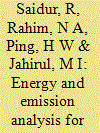

|
|
|
|
|
| Publication |
2009.
|
| Summary/Abstract |
The industrial sector is the largest user of energy in Malaysia. Industrial motors account for a major segment of total industrial energy use. Since motors are the principle energy users, different energy savings strategies have been applied to reduce their energy consumption and associated emissions released into the atmosphere. These strategies include using highly efficient motors, variable speed drive (VSD), and capacitor banks to improve the power factor. It has been estimated that there can be a total energy savings of 1765, 2703 and 3605 MWh by utilizing energy-efficient motors for 50%, 75% and 100% loads, respectively. It was also found that for different motor loads, an estimated US$115,936 US$173,019 and US$230,693 can be saved in anticipated energy costs. Similarly, it is hypothesized that a significant amount of energy can be saved using VSD and capacitor banks to reduce speed and improve the power factor, thus cutting energy costs. Moreover, a substantial reduction in the amount of emissions can be effected together with the associated energy savings for different energy savings strategies. In addition, the payback period for different energy savings strategies has been found to be reasonable in some cases.
|
|
|
|
|
|
|
|
|
|
|
|
|
|
|
|
| 3 |
ID:
091697
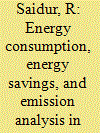

|
|
|
|
|
| Publication |
2009.
|
| Summary/Abstract |
This paper is concerned with the estimation of energy use in office buildings in Malaysia and with the energy use of major equipment. Energy intensity (EI) - a measure of a building's energy performance - is estimated for Malaysia and compared with a number of selected countries. Air conditioners are shown to be the major energy users (57%) in office buildings, followed by lighting (19%), lifts and pumps (18%) and other equipment (6%). It is estimated that 77,569 MWh of energy can be saved and a huge reduction of emissions achieved through the application of advance glazing, compact fluorescent lamps (CFL), insulation, housekeeping, and by raising thermostat set point temperature of air conditioners, and reducing EI.
|
|
|
|
|
|
|
|
|
|
|
|
|
|
|
|
| 4 |
ID:
097441
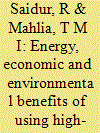

|
|
|
|
|
| Publication |
2010.
|
| Summary/Abstract |
Electric motors use major share (i.e. about 30-80% of total industrial energy consumption) of total industrial energy use around the world. Experiences from other countries show that government intervention in the form of regulations such as mandatory and voluntary approaches can save sizeable amount of energy along with the reduction in emissions associated with energy savings. This paper presents potential energy savings by introducing high-efficiency motors as a case study in Malaysian industrial sector. Emission reductions associated with the energy savings has been estimated and presented as well. It was also estimated that a cumulative amount of 1940 and 892 GWh of energy can be saved for 20 and 120 kW motors, respectively, in Malaysia relative to BAU over the next 10 years. Similarly, a cumulative amount of USD 100 million and USD 60 million can be saved as utility bills for the same motor categories. It has been found that the payback period of different capacities of motors are less than a year. Based on results, it was found that 1789 million kg of CO2 emission can be avoided by replacing standard motors with high-efficiency motors.
|
|
|
|
|
|
|
|
|
|
|
|
|
|
|
|
| 5 |
ID:
097484
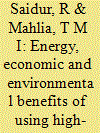

|
|
|
|
|
| Publication |
2010.
|
| Summary/Abstract |
Electric motors use major share (i.e. about 30-80% of total industrial energy consumption) of total industrial energy use around the world. Experiences from other countries show that government intervention in the form of regulations such as mandatory and voluntary approaches can save sizeable amount of energy along with the reduction in emissions associated with energy savings. This paper presents potential energy savings by introducing high-efficiency motors as a case study in Malaysian industrial sector. Emission reductions associated with the energy savings has been estimated and presented as well. It was also estimated that a cumulative amount of 1940 and 892 GWh of energy can be saved for 20 and 120 kW motors, respectively, in Malaysia relative to BAU over the next 10 years. Similarly, a cumulative amount of USD 100 million and USD 60 million can be saved as utility bills for the same motor categories. It has been found that the payback period of different capacities of motors are less than a year. Based on results, it was found that 1789 million kg of CO2 emission can be avoided by replacing standard motors with high-efficiency motors.
|
|
|
|
|
|
|
|
|
|
|
|
|
|
|
|
| 6 |
ID:
094894
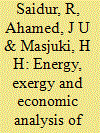

|
|
|
|
|
| Publication |
2010.
|
| Summary/Abstract |
In this paper, the useful concept of energy and exergy utilization is analyzed, and applied to the boiler system. Energy and exergy flows in a boiler have been shown in this paper. The energy and exergy efficiencies have been determined as well. In a boiler, the energy and exergy efficiencies are found to be 72.46% and 24.89%, respectively. A boiler energy and exergy efficiencies are compared with others work as well. It has been found that the combustion chamber is the major contributor for exergy destruction followed by heat exchanger of a boiler system. Furthermore, several energy saving measures such as use of variable speed drive in boiler's fan energy savings and heat recovery from flue gas are applied in reducing a boiler energy use. It has been found that the payback period is about 1 yr for heat recovery from a boiler flue gas. The payback period for using VSD with 19 kW motor found to be economically viable for energy savings in a boiler fan.
|
|
|
|
|
|
|
|
|
|
|
|
|
|
|
|
| 7 |
ID:
059439
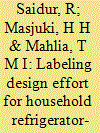

|
|
|
|
|
|
|
|